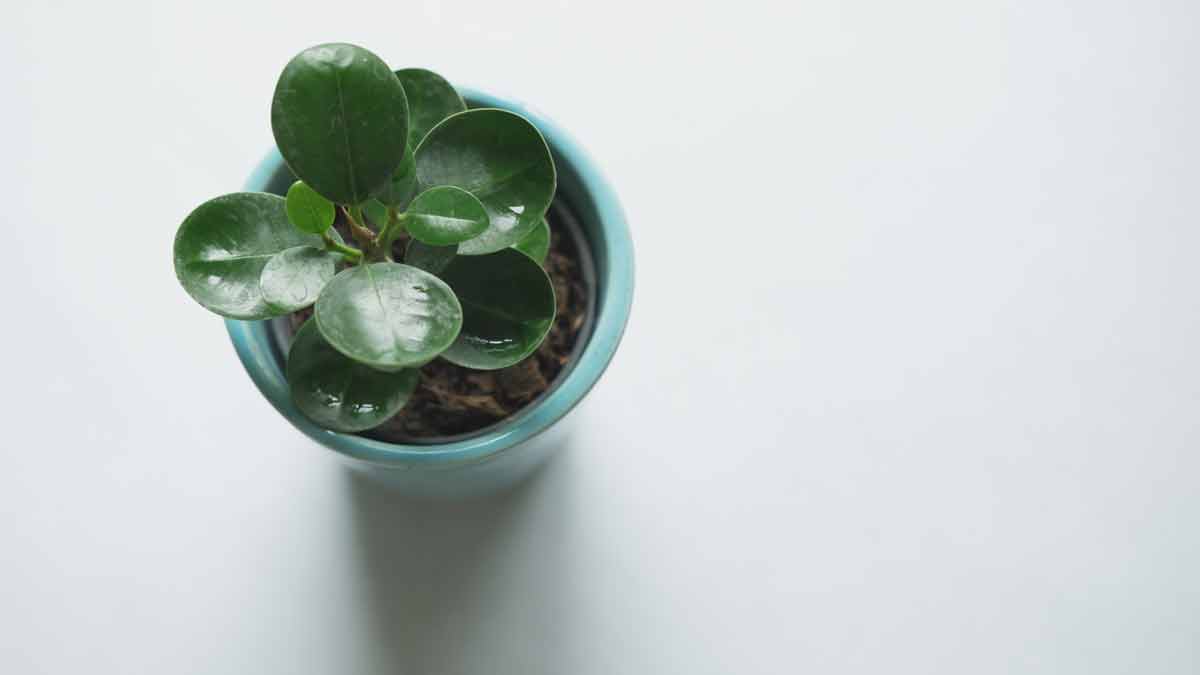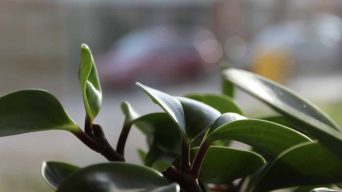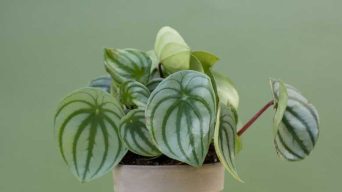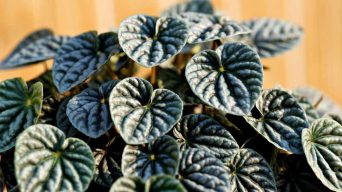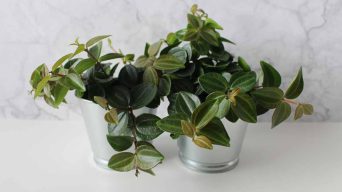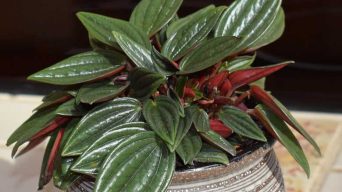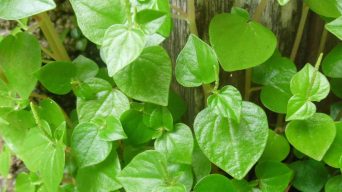Key Takeaways
- Peperomia leaves curl due to improper watering, inadequate lighting, temperature and humidity fluctuations, root rot, pest infestations, overfertilization, or nutrient deficiencies.
- To address curling leaves in Peperomia, fine-tune your watering habits to balance the plant’s moisture requirements. Enhance lighting by positioning it near an east or west-facing window for steady, filtered sunlight, or opt for artificial grow lights. Control temperature and humidity by setting the plant on a pebble-filled tray with water or using a humidifier nearby.
- Quick identification and treatment of pests are crucial to protect Peperomia plants from damage caused by mealybugs, mites, fungus gnats, and shoreflies. Supplement with nitrogen-rich fertilizers for leaf development, potassium-rich fertilizers for strong roots, phosphorus for root growth and energy transfer, calcium for structural support and healthy cell walls, and magnesium to aid photosynthesis and enhance foliage health. Repotting is also an effective remedy for issues related to overwatering or nutrient deficiencies, often manifest as curled leaves.
If you take pride in owning a Peperomia plant, you’re already aware of how these stunning, low-maintenance houseplants can add a touch of elegance to your indoor environment.
However, are you aware that curling leaves might signal an underlying issue within the lush greenery?
Here, we’ll explore various causes behind Peperomia leaves curling – from improper watering habits to nutrient deficiencies – and provide solutions to restore your beloved green friend’s health.
Identifying the Causes of Peperomia Leaf Curling
There are various reasons why the leaves of Peperomia plants may curl.
These include problems with watering, lighting, temperature and humidity, root rot, pest attacks, excessive fertilization, and lack of nutrients.
1. Improper Watering
One of the leading causes of Peperomia’s leaves curling is improper watering.
This resilient houseplant can tolerate both overwatering and underwatering to some extent, but when pushed beyond its limits, the plant’s health will decline, leading to curled leaves.
Underwatered Peperomias tend to exhibit a wilted appearance accompanied by leaf curling as they try to conserve water by reducing the surface area exposed for transpiration.
To maintain a healthy balance in your Peperomia’s hydration needs, check the moisture level of its potting soil before each watering session.
Use your finger or a moisture meter to gauge if it’s time for another drink; ideally, only water when about 50% of the potting mix has dried.
When you water your Peperomia plant, use ample amounts so that excess water drains from the bottom of the container — this helps emulate natural rainfall while preventing roots from being submerged in standing water.
2. Lighting Issues
Lighting is crucial to your Peperomia plant’s overall health and well-being.
These tropical plants thrive in bright, indirect sunlight, making lighting issues one of the common causes of leaves curling.
Insufficient light exposure can cause the foliage to struggle with photosynthesis, leading to weaker cell walls and curled leaves.
To provide optimal lighting conditions for your Peperomia, place it near an east or west-facing window where it will receive consistent filtered sunlight.
Begin to observe your plant’s response to the new lighting arrangement, as this will help you gauge whether the lighting is adequate or if adjustments are needed.
If natural light is limited in your home environment, consider supplementing with artificial grow lights designed for indoor plants.
3. Temperature And Humidity Stress
Temperature and humidity stress are significant factors that can lead to curling leaves in Peperomia plants.
These tropical houseplants thrive best in temperatures ranging from 65 to 80 degrees Fahrenheit, with a humidity level of around 40-50%.
In environments with low humidity, these plants may struggle to maintain their lush foliage, leading to stress symptoms such as curling leaves.
To maintain appropriate temperature and humidity levels for your Peperomia, place it away from drafty windows or direct heat sources like radiators or air conditioning vents.
If necessary, utilize a humidifier nearby to bolster moisture levels in dry indoor spaces.
Additionally, placing the potted plant on a tray filled with water and pebbles can help create a microclimate with increased ambient humidity surrounding the plant.
4. Root Rot
Root rot is a common problem among Peperomia plants that can cause their leaves to curl.
This condition usually occurs when the soil around the plant becomes waterlogged and lacks proper drainage, leading to an overgrowth of harmful fungi and bacteria in the root system.
A clear sign of root rot is a foul odor from the potting mix or black spots on the roots.
To fix this issue, carefully excavate your plant, removing all affected roots with sharp scissors or pruning shears before repotting it in dry, fresh potting soil that drains well.
Applying a rooting hormone can stimulate new growth and help restore your plant’s health.
5. Pest Infestations
One of the common causes of leaves curling is pest infestation. Mealybugs, mites, fungus gnats, and shoreflies are some pests that can infect Peperomia plants.
These tiny bugs can damage the plant by feeding on its leaves or sucking out its sap, resulting in curled leaves.
To avoid pest infestations, practice proper plant care, such as watering your plant correctly and providing adequate lighting conditions.
Regularly monitor your plant for any signs of a pest infection and take quick action to treat it before it spreads.
6. Overfertilization
Overfertilization is a key factor behind the curling of plant leaves.
This issue arises when an excessive amount of fertilizer is added to the soil, resulting in a harmful accumulation of salts. These salts can damage the plant’s roots and lead to dehydration.
Indicators of overfertilization include the presence of brown leaf tips or black spots on the foliage.
To avoid this problem, it’s crucial to adhere to proper fertilizing practices and opt for a balanced liquid fertilizer designed for houseplants.
Additionally, periodically flushing out excess salts is advisable. This can be done by watering the plant with plain water until it drains freely through the pot’s drainage holes.
7. Nutrient Deficiencies
Peperomia plants may suffer from nutrient deficiencies, leading to curled leaves as a sign of their struggle to access essential minerals and vitamins necessary for their growth and development.
A lack of nitrogen, phosphorus, potassium, or trace elements like magnesium and calcium can adversely affect the plant’s health.
Nitrogen deficiency, for example, can cause older leaves to yellow and newer leaves to become smaller and curl, as nitrogen is crucial for leaf development and growth.
Similarly, a lack of potassium can lead to leaf curling and discoloration.
To counteract nutrient deficiencies, consider using a balanced, water-soluble fertilizer that provides a comprehensive mix of nutrients.
Apply this according to the package instructions, typically every 4-6 weeks during the growing season.
Specific supplements like calcium or magnesium can be added for more targeted deficiencies.
How To Treat Curling Leaves In Peperomia Plants
Noticing curling leaves on your Peperomia can be concerning, but several effective ways exist to address this issue.
1. Adjust Watering Habits
Proper watering is essential in addressing curled leaves in Peperomia plants.
Follow these guidelines to ensure optimal hydration:
- Water the plant only when the top inch of the soil is dry to the touch.
- Use room-temperature water, steering clear of hard water containing minerals that could harm the plant.
- Ensure deep and thorough watering, but be cautious of overwatering to avoid root rot.
- Allow excess water to drain completely from the pot’s bottom to prevent waterlogging.
- To accurately assess soil moisture, consider using a moisture meter or check by inserting your finger into the soil.
2. Improve Lighting Conditions
To improve lighting conditions for your Peperomia and prevent leaf curling, follow these tips:
- Place the plant in a location with bright, indirect light, such as near a north-facing window.
- Avoid placing the plant in direct sunlight, which can cause sunburn and leaf damage.
- Consider using artificial grow lights if natural light is insufficient.
- If your Peperomia exhibits leggy growth or stretching towards the light source, consider moving it to a brighter location or adjusting the position of the grow lights.
- Monitor the plant regularly and adjust its placement or lighting as needed.
Keep in mind that various types of Peperomia may have distinct lighting needs. To ensure optimal growth conditions, it’s important to research the specific requirements of your Peperomia variety.
3. Regulate Temperature And Humidity Levels
Maintaining suitable temperature and humidity levels is crucial to prevent Peperomia from curling.
Here are some tips on how to regulate them effectively:
- Keep the plant in a place with temperatures ranging from 65°F to 75°F (18°C to 24°C) during the day and between 60°F and 65°F (15°C to 18°C) at night.
- Avoid exposing the plant to extreme temperature changes, such as drafts or air conditioning vents.
- Use a humidifier or place a water tray near the plant to increase humidity. Alternatively, mist the leaves regularly using a spray bottle.
- Ensure adequate air circulation around the plant, but avoid placing it in areas with strong winds or cold drafts.
4. Identify And Treat Pests
Pests like mites, aphids, and mealybugs can lead to curling leaves in Peperomia plants.
Immediate action is crucial for spotting any pests on your plant. Follow these steps for effective management:
- Gently wipe off visible pests from the leaves and stems using a damp cloth or sponge.
- Treat affected areas with natural insecticidal soap or neem oil to eliminate lingering pests.
- For severe infestations, a commercial pesticide designed for houseplants may be necessary.
- Continuously check your plant for new signs of bugs and address them quickly to avoid further harm.
Preventive measures are essential in pest management.
Maintaining your Peperomia’s health through regular care, including proper watering and fertilization, and keeping its surrounding area clean. This approach minimizes the chances of pest infestations, helping your plant’s leaves remain robust and vibrant.
5. Supplement Nutrients
To help prevent Peperomia leaves from curling due to nutrient deficiencies, plant owners can supplement their plants with the following macronutrients and micronutrients:
- Nitrogen: This is critical for plant growth and green leaf development. A low nitrogen concentration in the soil may cause yellowing of leaves, which can eventually lead to curling. Apply a liquid fertilizer or slow-release nitrogen granules to the potting soil.
- Phosphorus: This helps in root development and contributes to overall well-being by aiding energy transfer within the plant’s cells. Potassium-rich fertilizers are used to supplement phosphorus.
- Potassium: This essential macronutrient promotes strong roots and stress resistance and increases fruit or flower production. It also helps regulate water balance within the plant’s cells.
- Calcium: Calcium is crucial in giving structural support, forming healthy cell walls, promoting deeper green colors on leaves, and stimulating new growth.
- Magnesium: Magnesium aids photosynthesis, keeping plants green with healthy foliage.
Plant owners should ensure they are not overfertilizing their Peperomia plants, which can lead to further issues such as root burn or salt buildup in the potting mix.
Read fertilizer instructions carefully before applying them and follow them closely for proper plant care of your Peperomia.
6. Repot The Plant
To help address issues with overwatering or nutrient deficiency that may be causing plant leaves to curl, repotting the plant in fresh soil can be an effective solution.
Here are the steps to follow:
- Choose a new pot that is slightly larger than the current one and has drainage holes to prevent water buildup.
- Gently remove the plant from its current pot, careful not to damage the roots.
- Remove any dead or damaged roots and old soil that appears compacted or waterlogged.
- Add fresh, well-draining potting mix to the new pot until it is about one-third full.
- Place the plant in the new pot and add more potting mix around it, filling up to about an inch below the pot’s rim.
- Water thoroughly until water drains out of the bottom of the pot.
- Allow the plant to settle in its new environment for a few days before returning to regular watering and care routines.
Repotting can help improve drainage and provide fresh nutrients for your Peperomia plant, leading to healthier foliage and less leaf curling.
Prevention And Maintenance Tips For Healthy Peperomia Leaves
To ensure your Peperomia leaves remain vibrant and thriving, follow these key guidelines:
1. Use Well-draining Soil
Well-draining soil is crucial for keeping your Peperomia plant healthy and preventing leaves from curling.
When potting your plant, use a high-quality mix that allows excess water to drain away quickly.
Poor-quality potting soil can cause Peperomias to curl because it does not allow proper drainage.
Overwatering and using heavy, poorly draining soil are common causes of this issue.
If you suspect that poor drainage is causing your Peperomia’s leaf curling problem, repotting the plant using a well-draining mix can help alleviate the issue significantly.
2. Water Regularly But Not Too Often
Proper watering is crucial to prevent Peperomia leaves from curling.
While watering your plant regularly is essential, overwatering and underwatering can be detrimental.
Overwatering can lead to root rot, whereas underwatering may not provide enough moisture for healthy growth, leaving the soil excessively dry.
To determine when to water your Peperomia plant, you can check the soil moisture level by inserting your finger about an inch deep into the soil.
If the top layer of soil feels dry, it’s time to give your plant some water.
Well-draining soil that facilitates adequate drainage can also help regulate moisture levels and prevent overwatering.
Additionally, avoid using tap water with high salts or hard minerals that could damage roots or hinder nutrient absorption.
Instead, use distilled or filtered water if possible.
3. Place In A Suitable Environment
To maintain a healthy Peperomia, providing them with a suitable environment is crucial.
These plants prefer bright but indirect sunlight and temperatures between 60-75°F.
Avoid placing them in direct sunlight, as this can burn the leaves.
It’s also important to consider the location of your plant within your home or office.
Keep them away from drafty areas like near open windows or air conditioning vents that can cause temperature fluctuations.
Finally, ensure they’re not placed too close to other plants where pests could spread quickly.
4. Regularly Monitor And Care For Your Peperomia Plant
Regular monitoring and care are crucial to keep your Peperomia plant healthy and prevent curling leaves.
This entails observing the plant’s development and condition, identifying any indications of pests or diseases, and ensuring it receives sufficient nutrients and water.
Inspecting the leaves for discoloration, spots, or wilting is a good practice.
Regular maintenance, such as removing dead leaves, pruning unhealthy parts of the plant, repotting when necessary, and cleaning dust off the leaves with a damp cloth, can promote healthy growth.
Remember that each Peperomia variety has different care needs; therefore, research your specific type to ensure you’re giving it proper care throughout its lifespan.
5. Be Patient As The Plant Adjusts
Peperomia plants can take some time to adjust to their environment, especially if they have been recently transplanted or moved to a new location.
It’s important not to rush things and give your plant time to settle in before making any drastic changes.
Another key factor in helping your Peperomia thrive is providing it with proper lighting conditions.
While these plants don’t require direct sunlight, they need bright indirect light to photosynthesize effectively.
Final Thoughts
Curled leaves in your Peperomia plant can indicate various issues, such as improper watering, lighting problems, temperature and humidity stress, pest infestations, and nutrient deficiencies.
To restore your plant’s health, accurately identify and address the underlying issues by adjusting watering habits, improving light conditions, or regulating temperature levels.
Moreover, prevention is key. Employing well-draining soil and diligently caring for your Peperomia through consistent monitoring can guarantee its healthy development.

